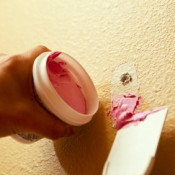 To fill nail holes in your walls where pictures once hung, mix up a couple of teaspoons of cornstarch and add water until it's a putty-like consistency. It dries relatively quickly and works like a charm.
To fill nail holes in your walls where pictures once hung, mix up a couple of teaspoons of cornstarch and add water until it's a putty-like consistency. It dries relatively quickly and works like a charm.
By Oak-Trees
This page contains the following solutions.
An easy way to patch small holes in the wall is to use white toothpaste (not the gel type) and smooth. It can be painted over or covered with wallpaper. It can also be touched up with colored pens.
When you want/ need to cover up a nail hole on your wall, use white toothpaste. Put a little bit on the tip of your finger spread it smoothly over the nail hole. When it dries you can paint over it or leave as is.
I recently moved a picture in my dining room. There were nail holes left in the wall. We had guests coming for dinner.
If the nail hole is big enough, use a toothpick to fill it, break it off, sand lightly, and cover with the white toothpaste. Or you can use Elmer's white glue to cover the toothpick. Toothpaste may fall out but the glue will stay. Just make sure you wipe off the excess.
Here are the questions asked by community members. Read on to see the answers provided by the ThriftyFun community.
Tips for patching nail holes in dry wall. Post your ideas.

Unsightly nail holes on your walls? Make up a paste of cornstarch & water. Fill the nail holes with this paste, and let dry.
By Terri
I recall reading that white toothpaste ( not gel) can be used to fill nail holes in the walls. Sounds easy to me.
I usually use all purpose joint compound that you can buy in a 1 quart plastic container. Keep lid closed tightly and it will last a long time. I've used plain white toothpaste (not gel) and that works also.
I'll tell you one thing, don't patch a hole in the wall when your step mom wants to sell the house and only wants to paint over the holes.. You get all kinds of hell even if you think you did good.. Make sure they want them filled first, I learned the hardway.
My millennial friends say they use ramen noodles to fill holes and cover scratches on many different surfaces.
What do they use to get the ramen to stay in the hole? I have seen some videos but many of them look like a joke.
I would be interested in hearing from someone who had used this technique successfully.